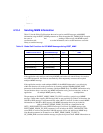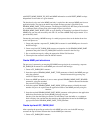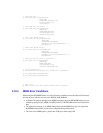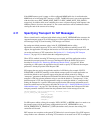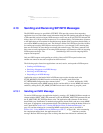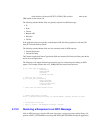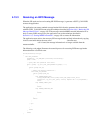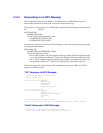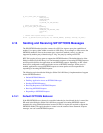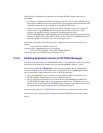default:
printf(" Received Unknown Error cause\n");
break;
}
}
4.13 Sending and Receiving SIP INFO Messages
The SIP INFO message (as specified in IETF RFC 2976) provides a means for transporting
application-level, session-related control information along the SIP signaling path after the setup of
a SIP-controlled session has begun. INFO messages can be sent on an early INVITE-initiated SIP
dialog (after a 101-199 provisional response) or on a confirmed dialog. The information of interest
to the application can be contained in standard message header fields, proprietary header fields, or
one or more MIME-encoded body parts. The Dialogic
®
Global Call API library provides facilities
for sending and receiving INFO requests and responses on a “pass-through” basis, meaning that
there are no Global Call state changes associated with such messages. The library generates Call
Info events to notify applications of incoming INFO messages, and Extension events for incoming
INFO response messages. The Send Message API is used for outgoing INFO
requests and responses.
Only one INFO request can be pending on a dialog. Once an INVITE request has been sent,
another one cannot be sent until a response has been received.
The following topics discuss how applications can send, receive, and respond to INFO requests.
• Sending an INFO Message
• Receiving a Response to an INFO Message
• Receiving an INFO Message
• Responding to an INFO Message
Application access to the header fields in INFO messages requires that the mask value
IP_SIP_MSGINFO_ENABLE must be set into the sip_msginfo_mask field of the
IP_VIRTBOARD configuration data structure before is called. Additionally, INFO
messages frequently utilize MIME message bodies, and the ability to access MIME data must be
enabled by setting the IP_SIP_MIME_ENABLE mask value in the same sip_msginfo_mask.
4.13.1 Sending an INFO Message
To send an INFO message, the application begins by creating a GC_PARM_BLK that contains an
element with the IPSET_MSG_SIP parameter set ID, the IPPARM_MSGTYPE parameter ID and
the IP_MSGTYPE_SIP_INFO parameter value. The application adds elements for the desired
header fields (any combination of standard and proprietary header fields) and one or more MIME
body parts, if appropriate, to the parameter block. (The technique for setting the header fields to be
sent is described in Section 4.9.5, “Setting SIP Header Fields for Outbound Messages”, on
page 183, and the technique for constructing MIME-encoded body parts is described in
Section 4.10, “Using MIME Bodies in SIP Messages (SIP-T)”, on page 188.) After constructing
the complete parameter block, the application uses the function to send the
message. Because INFO messages relate to dialogs that have been initiated or confirmed, the



